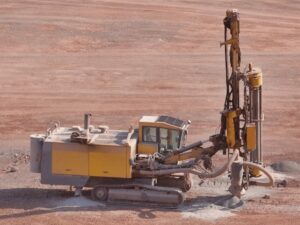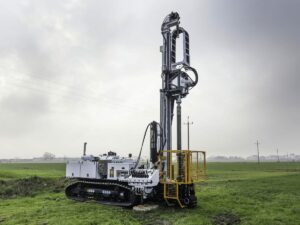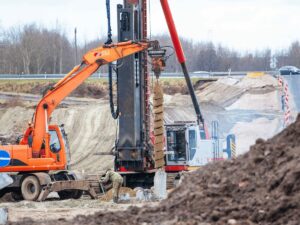Are you torn between sonic drilling and rotary drilling for your next construction project? The choice could significantly impact the quality, efficiency, and cost of your building.
With years of industry experience and a focus on this sector, we provide insights that are both actionable and tailored to your needs.
In this comprehensive guide, we will dissect the differences between sonic drilling and rotary drilling—covering everything from efficiency and accuracy to cost and environmental impact.
Read on to get the lowdown on which drilling method aligns best with your business objectives.
1. The Basics of Drilling Techniques
Drilling is a foundational aspect of any construction project, especially in specialized facilities like gyms where structural integrity is paramount. Two prevalent methods in the industry are sonic drilling and rotary drilling. Sonic drilling utilizes high-frequency, resonant energy to penetrate the ground, offering advantages like precise core samples and minimal waste.
It’s a technique that’s often favored for environmental sampling and geotechnical investigations. On the other hand, rotary drilling employs a rotating drill bit to cut through the earth. This method is generally more cost-effective and is widely used in various construction projects, including the development of gym facilities. Rotary drilling is versatile and capable of penetrating different types of soil and rock formations.
Understanding the basics of these two drilling techniques is crucial for making informed decisions, whether you’re a gym owner, a construction specialist, or a distributor of fitness equipment.

2. Overview of Sonic Drilling
Sonic drilling has gained prominence due to its precision and efficiency. Here are the core principles that drive this technique, along with its common applications and the advantages and drawbacks that accompany it.

Definition and Core Principles
Sonic drilling operates on the principle of resonant energy. A sonic drill head swings at high frequencies, generating vibrations that melt the soil or rock, allowing for easier penetration. This method is particularly useful for obtaining undisturbed core samples, a feature that’s highly valued in environmental and geotechnical studies.
The core principles of sonic drilling revolve around speed, accuracy, and minimal environmental impact. The technique is designed to reduce friction on the drill string and bit, enabling faster and more efficient drilling. This makes it a preferred choice for projects requiring high levels of precision.
Common Applications
Sonic drilling is a versatile technique with applications in a variety of industries. Here are five key areas where it is commonly used:
Environmental Sampling
Sonic drilling is frequently employed to collect soil and water samples for environmental assessments. The technique’s ability to produce undisturbed samples makes it highly suitable for accurate testing. This is particularly important for projects that require stringent environmental compliance, such as the construction of new gym facilities.
Environmental sampling using sonic drilling is often mandated by regulatory bodies. It provides reliable data that can be crucial for obtaining project approvals, and ensuring that environmental standards are met.
Geotechnical Investigations
Understanding the properties of soil and rock formations is essential for any construction project. Sonic drilling is commonly used during the planning stages to gather this vital information. It’s especially useful for gym facilities that require a strong foundation and want to avoid any geological surprises.
Geotechnical investigations with sonic drilling can provide data that informs the project’s design and construction methods. This ensures not only the safety but also the long-term viability of the structure.
Groundwater Monitoring
Monitoring groundwater levels and quality is another common application for sonic drilling. The method’s precision ensures that monitoring equipment can be placed accurately. This is crucial for projects that are sensitive to water table levels, such as agricultural developments or urban planning.
Groundwater monitoring is often a long-term commitment, and the accuracy of sonic drilling ensures that the data collected will be reliable for years to come. This makes it a preferred method for sustainable projects.
Mineral Exploration
In the mining industry, sonic drilling is used to explore mineral deposits. The high-quality core samples obtained are essential for assessing the viability of mining operations. This is particularly important for projects that require a detailed understanding of mineral composition and distribution.
The data collected through sonic drilling can be pivotal in deciding whether a mining project is economically feasible. It can also guide the extraction process, ensuring maximum yield and minimal environmental impact.
Each of these applications leverages the unique advantages of sonic drilling, making it a preferred choice for projects that require both high levels of accuracy and consideration for environmental impact.
Advantages and drawbacks
Understanding the advantages and drawbacks of sonic drilling is crucial for making an informed decision for your construction project. This section provides a comprehensive list of the pros and cons to consider.
Advantages of Sonic Drilling
- High Precision: Sonic drilling allows for the collection of highly accurate, undisturbed core samples, making it ideal for environmental and geotechnical studies.
- Speed: The method is generally faster than other drilling techniques due to reduced friction, allowing projects to be completed more quickly.
- Minimal Waste: Sonic drilling produces fewer drill cuttings and waste material, contributing to cleaner and more environmentally friendly operations.
- Versatility: The technique is capable of drilling through a wide range of soil types and rock formations, offering greater flexibility in project applications.
- Reduced Noise: Sonic drilling tends to be quieter than other methods, minimizing noise pollution and making it more suitable for urban or sensitive environments.
- Less Fluid Required: The method often requires less drilling fluid, reducing the environmental impact and lowering operational costs.
- Safety: The high level of control and precision reduces the risk of accidents, making sonic drilling a safer option for operators.
Drawbacks of Sonic Drilling
- Cost: Sonic drilling is generally more expensive than other methods, particularly for large-scale projects, which could be a concern for budget-sensitive endeavors.
- Equipment Complexity: The specialized equipment required for sonic drilling can be complex to operate, necessitating skilled labor.
- Limited Depth: While effective for many applications, sonic drilling may not be suitable for extreme drilling projects.
- Preliminary Assessment Required: The method may not be effective for all soil types, requiring a thorough initial evaluation to determine its suitability.
- Energy Consumption: Sonic drilling can consume more energy compared to other drilling methods, potentially increasing operational costs.
Knowing this is essential for selecting the most suitable drilling method for your specific needs. This aims to equip you with the insights necessary to make a well-informed choice, tailored to the unique requirements of your project.
3. Overview of Rotary Drilling
Rotary drilling is another widely-used drilling technique, especially popular for large-scale construction projects. Here we’ll explore the fundamentals that govern rotary drilling. Let’s take a closer look below:
Definition and Core Principles
Rotary drilling operates by using a rotating drill bit to cut through the earth’s surface. The drill bit is attached to a string of drill pipes, and as it rotates, it breaks up the soil or rock, allowing for deeper penetration. This method is particularly effective for drilling through a variety of soil types and rock formations, making it a versatile choice for many construction projects, including gym facilities.
The core principles of rotary drilling focus on efficiency and adaptability. The technique is designed to handle different ground conditions and is often used in projects that require deep drilling. Its versatility and cost-effectiveness make it a popular choice for a wide range of applications, from commercial construction to oil and gas exploration.
Common Applications
Rotary drilling is a versatile technique with a wide range of applications across various sectors. Here are five key areas where rotary drilling is commonly employed:
Oil and Gas Wells
Rotary drilling is the primary method for drilling deep oil and gas wells. Its ability to reach great depths efficiently makes it indispensable in the energy sector. This is particularly crucial for projects that require access to deep reservoirs of oil or gas.
The method’s efficiency allows for quicker project completion, which can be a significant advantage in the fast-paced energy sector. It’s a reliable choice for projects that demand both depth and speed.
Geothermal Energy Production
This method is used to drill deep into the Earth’s crust to tap into geothermal energy sources. Its efficiency and depth capabilities make it ideal for this renewable energy application. This is especially important for projects focused on sustainable energy production.
Geothermal drilling often requires reaching great depths to access high-temperature resources. Rotary drilling’s depth capabilities make it a preferred choice for such demanding projects.
Water Wells
Rotary drilling is commonly used for digging deep water wells, especially in areas with hard rock formations. Its speed and efficiency make it a preferred choice for accessing groundwater. This is crucial for regions that rely on well water for both residential and agricultural use.
The method’s adaptability to different soil types makes it versatile for this application. Whether the project involves sandy soil or hard rock, rotary drilling can handle it efficiently.
Blast Hole Drilling
In mining operations, rotary drilling is used to create blast holes for explosives. The method’s speed and efficiency are crucial for maintaining the pace of mining activities. This is especially important in open-pit mining where large volumes of ore need to be extracted.
The speed of rotary drilling allows for quicker project turnaround, which can be a significant advantage in the competitive mining sector. Its reliability and efficiency make it a go-to choice for blast hole drilling.
These applications demonstrate the versatility of rotary drilling, making it a reliable choice for a variety of projects that require both depth and adaptability.

Advantages and Drawbacks
Selecting the right drilling method is a crucial step in ensuring the success of your construction project. In this section, we outline the key advantages and drawbacks of rotary drilling to help you make an informed decision.
Advantages of Rotary Drilling
- Cost-Effectiveness: Rotary drilling is generally more budget-friendly, especially for large-scale projects, making it a go-to choice for cost-sensitive endeavors.
- Depth Capability: This method can reach greater depths compared to other drilling techniques, making it ideal for projects like oil and gas wells that require deep drilling.
- Ease of Operation: Rotary drilling equipment is typically easier to operate and requires less specialized training, reducing labor costs.
- Adaptability: The method can be adapted for both vertical and horizontal drilling, offering greater flexibility in project applications.
- Strong in Hard Formations: Rotary drilling is particularly effective in hard rock formations where other methods might struggle.
- High Drilling Rate: The technique offers a high rate of penetration, allowing projects to be completed in a shorter timeframe.
- Wider Range of Bit Options: Rotary drilling allows for the use of various types of drill bits, making it adaptable to different ground conditions.
Drawbacks of Rotary Drilling
- Environmental Impact: The method can produce a significant amount of waste material, posing environmental concerns.
- Lower Precision: Rotary drilling is generally less precise than sonic drilling, which may not be suitable for projects requiring highly accurate core samples.
- Higher Noise Levels: The method tends to be noisier, which could be a concern in residential or environmentally sensitive areas.
- Fluid Requirement: Rotary drilling often requires the use of drilling fluids, which could add to the operational costs and environmental impact.
- Maintenance Costs: The wear and tear on drill bits and other equipment components can lead to higher maintenance costs over time.
Weighing these advantages and drawbacks can guide you in choosing the most appropriate drilling method for your project, whether it involves the construction of a new gym facility, the expansion of an existing one, or other large-scale endeavors.
4. Key Differences Between Sonic and Rotary Drilling
Choosing between sonic and rotary drilling is an important decision that can influence the outcome of your construction project. Here are key differences between these two methods that can guide you:
| Key Differences |
Sonic Drilling |
Rotary Drilling |
| Precision vs. Cost-Effectiveness |
Known for high precision, especially in obtaining undisturbed core samples. |
Generally more cost-effective, particularly for large-scale projects. |
| Sustainability Impact |
Produces less waste and often requires fewer drilling fluids, making it environmentally friendly. |
Can generate more waste material and may require the use of drilling fluids. |
| Speed and Efficiency |
Fast due to reduced friction, beneficial for projects with tight timelines. |
Offers a high penetration rate, especially in hard rock formations. |
| Operational Complexity |
Equipment is generally more complex and requires specialized training. |
Equipment is easier to operate, potentially reducing labor costs. |
| Depth Capabilities |
Efficient but may not be suitable for extremely deep drilling projects. |
Capable of reaching greater depths, ideal for projects like oil and gas wells. |
| Versatility in Drill Bits |
Versatile in soil types but may offer fewer options for drill bits. |
Allows for a wider range of drill bit options, offering greater adaptability to different terrains. |
This table provides a concise comparison of the key differences between sonic and rotary drilling, helping you make an informed decision based on your project’s specific needs.
5. 4 Tips for Choosing the Right Method for Your Project
Selecting the right drilling method is not just about understanding the technical aspects; it’s also about aligning those capabilities with your project’s unique requirements. Here are some tips to guide you in making an informed decision.
#1 Assess the Project’s Scale and Budget
Before diving into any drilling project, it’s crucial to have a clear understanding of its scale and budget. Larger, more budget-sensitive projects may benefit from the cost-effectiveness of rotary drilling. For example, if you’re a gym owner looking to construct multiple new facilities, rotary drilling could be a more budget-friendly option.
On the other hand, smaller projects that require high precision, like environmental assessments for a single gym location, may find sonic drilling to be more suitable.
#2 Consider the Ecosystem
Being environmentally responsible is not just good for the planet; it’s also increasingly becoming a regulatory requirement. Assess the environmental impact of your drilling method. For example, if your project is near a residential area, the reduced noise levels of sonic drilling could be a significant advantage.
Alternatively, if you’re working on a project that involves sensitive ecosystems, rotary drilling’s higher waste production could be a concern.
| Ecosystem Consideration |
Relevant Methodology |
Description |
| Project Complexity |
Waterfall, Agile, Scrum, Kanban |
Determine the level of complexity in your project. Waterfall may work for well-defined, stable projects, while Agile methodologies are suited for more dynamic and evolving projects. |
| Project Size |
Agile, Scrum, Kanban, SAFe |
Consider the size of the project team and scope. Agile methodologies can be adapted for small teams and scaled for larger ones through frameworks like SAFe. |
| Industry Compliance |
Waterfall, Regulatory Compliance |
If your project requires strict adherence to industry regulations or compliance standards, a Waterfall or regulatory-compliant approach may be necessary. |
| Stakeholder Involvement |
Agile, Scrum, Lean |
Evaluate how engaged stakeholders need to be throughout the project. Agile methodologies emphasize continuous collaboration with stakeholders. |
| Development Speed |
Lean, Agile, Scrum, Kanban |
Determine the speed at which the project needs to deliver results. Lean and Agile methodologies focus on iterative, quick deliveries. |
| Project Risk |
Waterfall, Agile, Risk Management |
Assess the level of risk associated with the project. Waterfall may be suitable when risks can be identified and mitigated upfront, while Agile allows for adaptive risk management. |
| Customer Feedback |
Agile, Scrum, Lean Startup |
Consider the importance of customer feedback and the ability to incorporate it into the project. Agile methodologies prioritize customer feedback and rapid iterations. |
| Team Expertise |
Methodology Familiarity |
Evaluate the experience and expertise of your project team. Choose a methodology that aligns with the team’s skills and familiarity. |
| Resource Availability |
Agile, Scrum, Kanban |
Check the availability of resources (time, budget, personnel) for the project. Agile methodologies are adaptable to changing resource constraints. |
| Technology Stack |
Methodology Alignment |
Ensure the chosen methodology aligns with the technology stack and tools used in the project. Some methodologies work better with specific technologies. |
| Project Goals and Objectives |
Methodology Alignment |
Align the project’s goals and objectives with the chosen methodology. Different methodologies may better suit specific project goals (e.g., innovation, cost reduction). |
| Continuous Improvement Focus |
Lean, Six Sigma |
If your project aims for continuous improvement and waste reduction, Lean or Six Sigma methodologies may be suitable. |
#3 Evaluate Soil and Rock Conditions
Understanding the ground conditions where you’ll be drilling is essential. Some methods are better suited for certain types of soil or rock. If you’re unsure, consider consulting with experts or using advanced equipment from trusted suppliers like Drillrigy to conduct preliminary assessments.
#4 Safety and Training Requirements
At Drillrigy, the team believes that safety should never be compromised. Consider the safety features of the drilling method you choose such as using Personal Protective Equipment (PPE), control features, emergency protocols, as well as the training required for your team to operate the equipment effectively. Sonic drilling generally requires more specialized training but offers higher levels of control, which can be an advantage.
Dive Deeper Into Our Resources
Looking for more diverse product options? Browse through our handpicked selections:
Still haven’t found what you’re looking for? Don’t hesitate to contact us. We’re available around the clock to assist you.
Conclusion
Choosing between sonic and rotary drilling is a complex decision that can significantly impact your construction project. This comprehensive guide aims to equip you with the insights and tips you need to make an informed choice tailored to your specific needs.
If you’re looking for advanced, reliable drilling equipment, consider Drillrigy for your next project. For more information, feel free to contact us.



